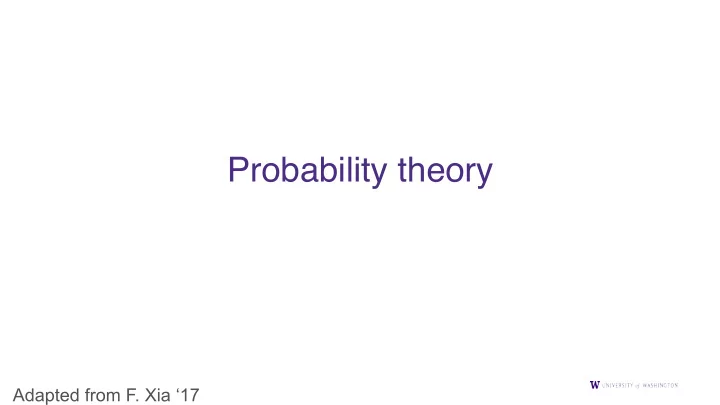

Probability theory Adapted from F. Xia ‘17
Basic concepts ● Possible outcomes, sample space, event, event space ● Random variable and random vector ● Conditional probability, joint probability, marginal probability
Random variable ● The outcome of an experiment need not be a number. ● We often want to represent outcomes as numbers. ● A random variable X is a function from the sample space to real numbers: Ω ➔ R. ● Ex: the number of heads with three tosses: X(HHT)=2, X(HTH)=2, X(HTT)=1, …
Two types of random variables ● Discrete: X takes on only a countable number of possible values. ● Ex: Toss a coin three times. X is the number of heads that are noted. ● Continuous: X takes on an uncountable number of possible values. ● Ex: X is the speed of a car (e.g., 56.5 mph)
Common distributions ● Discrete random variables: ● Uniform ● Bernoulli ● binomial ● multinomial ● Poisson ● Continuous random variables: ● Uniform ● Gaussian
Random vector ● Random vector is a finite-dimensional vector of random variables: X=[X 1 , …,X k ]. ● P(x) = P(x 1 ,x 2 ,…,x n )=P(X 1 =x 1 ,…., X n =x n ) ● Ex: P(w 1 , …, w n , t 1 , …, t n )
Notation ● X, Y: random variables or random vectors. ● x, y: some values ● P(X=x) is often written as P(x) ● P(X=x | Y=y) is written as P(x | y)
Three types of probability ● Joint prob P(x,y): the prob of X=x and Y=y happening together ● Conditional prob P(x | y): the prob of X=x given a specific value of Y=y ● Marginal prob P(x): the prob of X=x for all possible values of Y.
Chain rule: calc joint prob from marginal and conditional prob P ( A , B ) P ( A ) * P ( B | A ) P ( B ) * P ( A | B ) = = P ( A ,..., A ) P ( A | A ,... A ) ∏ = 1 n i 1 i 1 − i 1 >=
Calculating marginal probability from joint probability P ( A ) P ( A , B ) ∑ = B P ( A ) P ( A ,..., A ) ∑ = 1 1 n A ,..., A 2 n
Bayes’ rule P ( A , B ) P ( A | B ) P ( B ) P ( B | A ) = = P ( A ) P ( A ) y * arg max P ( y | x ) = y P ( x | y ) P ( y ) arg max = P ( x ) y arg max P ( x | y ) P ( y ) = y
Independent random variables ● Two random variables X and Y are independent iff the value of X has no influence on the value of Y and vice versa. ● P(X,Y) = P(X) P(Y) ● P(Y | X) = P(Y) ● P(X | Y) = P(X)
Conditional independence Once we know C, the value of A does not affect the value of B and vice versa. ● P(A,B | C) = P(A | C) P(B | C) ● P(A | B,C) = P(A | C) ● P(B | A, C) = P(B | C)
Independence and conditional independence ● If A and B are independent, are they conditionally independent? ● Example: ● Burglar, Earthquake ● Alarm
Independence assumption P ( A ,..., A ) P ( A | A ,... A ) ∏ = 1 n i 1 i 1 − i 1 >= P ( A | A ) ∏ ≈ i i 1 − i 1 >=
An example ● P(w 1 w 2 … w n ) = P(w 1 ) P(w 2 | w 1 ) P(w 3 | w 1 w 2 ) * … * P(w n | w 1 …, w n-1 ) ≈ P(w 1 ) P(w 2 | w 1 ) …. P(w n | w n-1 ) ● Why do we make independence assumptions which we know are not true?
Summary of elementary probability theory ● Basic concepts: sample space, event space, random variable, random vector ● Joint / conditional / marginal probability ● Independence and conditional independence ● Four common tricks: ● Chain rule ● Calculating marginal probability from joint probability ● Bayes’ rule ● Independence assumption
Recommend
More recommend